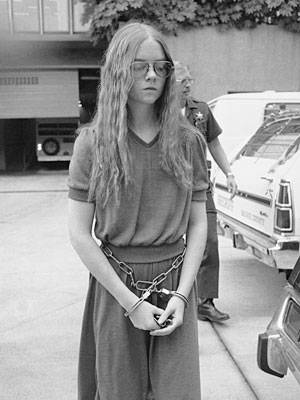“Ugh, it’s Monday” are the words that usually follow the arrival of the most dreaded day of the week. The sighs floating in the air are palpable and nothing seems possible. Mondays always carry with them a negative connotation and contain components such as depression, fatigue, and anguish. But to a San Diego elementary school, and to a troubled sixteen year old, Monday, January 29, 1979 held an even more distressing meaning.

Students at Grover Cleveland Elementary School, located in San Diego, California, began what they believed would be a normal Monday morning like any other, with bells ringing and students racing to their classes. Little did they know, however, that across the street, sixteen-year-old Brenda Ann Spencer was aiming her .22 caliber semiautomatic rifle right at society’s ultimate refuge, the elementary school, and its surroundings. After the first bell rang, Brenda broke the panels on the front door of her home, which was located right across the street from the elementary school. And she began to fire. The school’s principal, Burton Wragg, while rushing outside, was hit on the shoulder and chest with Spencer’s bullets and eventually died. Michael Suchar, the school’s custodian, ran outside with a blanket in order to cover Wragg and keep him from going into shock, but he quickly became the second victim of Spencer’s shooting and lost his life. In between all the chaos, 28 year old Robert Robb, a recent graduate of the police academy, while examining Wragg’s and Suchar’s bodies, was shot under his right shoulder blade.1 He would go on to survive though, along with the eight other children who were wounded in the incident. At least three of those children had abdominal wounds. A nine-year-old student, Cam Miller, was struck in the back with a bullet that exited through his chest without hitting any internal organs. Another, Christy Buell, was shot through her abdomen and in the buttocks, and had to undergo surgery in order to repair her intestine.2
When Gus Stevens, a reporter for the San Diego Evening Tribune, began calling around the area to gain more information about the shooting, he coincidentally placed a call to Spencer’s home where she gave him exactly what he wanted. She described the shooter, a sixteen year old, and the shooter’s address. When Stevens realized that she gave him her own address, he recognized what was going on and requested an interview while another staff member informed the police of the situation. The police, now aware of where the shots were coming from, were able evacuate the children and obstruct Spencer’s line of sight while trying to negotiate with her. After several hours, Brenda Spencer surrendered her weapon and several rounds of ammunition, and was subsequently arrested. While on the phone with Stevens, Spencer had stated that she was just shooting for the “fun of it.” She went on to say that she just didn’t like Mondays and did this “because it’s a way to cheer up the day.”3

Contrary to her initial claim, she later went on to state in her 2001 parole hearing that she had been “sexually abused by [her] father” and was “waiting for the cops to show up so they could shoot [her].”4 This new information has fueled many more theories today about Brenda Spencer’s true motives in committing such a crime. During her pretrial psychological testing, an injury to Spencer’s temporal lobe came to light. Spencer has also stated in a letter from prison that she experiences “grand mal seizures” that she has to counteract with medications.5 Such a brain injury would definitely be a precursor to epilepsy, which is two to four times more common among violent offenders than the public.6 The lack of treatment she received for this disease, to some, proves the neglect that she experienced from her family and in her childhood. Psychologist Jonathan Fast introduces the idea that her brain injury, abuse, and the effects of it pushed her to her final actions. He believes that the shame, ridicule, inferiority, and powerlessness that she felt encouraged her to go as far as she did. In another letter she wrote in prison, she stated that her “father had done everything a person could do to another person. The beatings, the touching, the emotional abuse.” She went on to state that no one, not teachers or counselors, gave her assistance through this, so she simply thought that this was how the world and how life worked. When her father gifted her the .22 caliber rifle, she thought that he was finally telling her to do it: to take her life successfully, unlike her past suicide attempts, and leave the world forever.7
Whether these theories are true or not, Brenda Spencer was tried as an adult and pleaded guilty to two counts of murder and nine counts of assault. She was sentenced to twenty-five years to life in prison, and is still serving her sentence at the California Institute for Women. The shooting has inspired a song by the Boomtown Rats called “I Don’t Like Mondays,” and has also gained other media coverage through a documentary.8 Her action went down in history as the first high profile school shooting and has become a vanguard to many future, unimaginable school situations and violent outbreaks. Whether Spencer was a cold-hearted killer or a truly lost and confused soul that simply wanted an escape, it is undeniable that her horrible actions have had some frightening consequences in our modern world.
- Jonathan Fast, Ceremonial Violence (New York: The Overlook Press, 2008), 25, 70-71. ↵
- Tamara Jones, “Look Back in Sorrow,” Good Housekeeping 227, no.5 (November 1998): 118. ↵
- Jonathan Fast, “Unforgiven and Alone: Brenda Spencer and Secret Shame,” in School Shootings: International Research, Case Studies, And Concepts For Prevention, ed. Nils Böckler (New York: Springer, 2013), 253-255. ↵
- Debra Sevey, “Subsequent Parole Consideration Hearing of Brenda Spencer,” (Capitol Electronic Reporting, 2001), 15-16. ↵
- Jennifer Furio, Letters From Prison: Voices Of Women Murderers (New York: Algora Pub., 2001), 134. ↵
- Jonathan Fast, ” Unforgiven and Alone: Brenda Spencer and Secret Shame,” in School Shootings: International Research, Case Studies, And Concepts For Prevention, ed. Nils Böckler (New York: Springer, 2013), 251. ↵
- Jennifer Furio, Letters From Prison: Voices Of Women Murderers (New York: Algora Pub., 2001), 134-135. ↵
- Encyclopedia of School Crime and Violence, September 2011, s.v. “Brenda Spencer,” by Laura L. Finley. ↵



243 comments
Richard Morales
I had never heard of this school shooting before reading this article; it’s interesting to think that school shootings have been happening long before I was born. An older woman once told me of a school shooting at her elementary school. She told me that an angry ex-husband went in to the school and shot his wife who was a teacher there. She also said that she didn’t think it made national news and they went back to school shortly after. Now a days, a school shooting gets a lot of media attention (which is appropriate). This leads to a lot of anxiety for teachers, students, and parents.
Maggie Amador
To think that this shooting was the first high profile school shooting is astonishing because of how many school shootings there have been since this one. While I’m sure that Brenda Spencer’s life at home was not easy, none of her actions are justifiable. The reason she gave is sickening because of the harm and terror it caused countless innocent people. It leaves me to wonder if Brenda Spencer was possibly bullied which could have been another underlying motive.
Pedro Gonzalez Aboyte
I had never heard of Brenda Spencer before reading this article, and it’s hard to believe any human being would ever think of doing something like this. It sickens me and angers me because she says she did it “for fun”. She was clearly in need of medical help and I understand that a probable cause for her shooting was her terrible childhood, but we shouldn’t have let it get that far. She shot and killed two men and injured children. There have been multiple shootings since Spencer’s and we have to do something to stop them. Whether it be getting help for those who have had a troubling past or any other way. Her intentions are still unclear, but we can’t afford to let shootings like this keep happening.
Noah Bolhuis
I hadn’t heard about this shooting, especially because some shootings get more coverage than others, and this one having took place so long ago, I’m not surprised. It was hard to follow the part where the article mentions the principal called the police and mentioned her address. I didn’t know heard what. However, I find it quite interesting how she was only sentenced to 25 years to life. I’m not sure if it was because she had a poor past, plead guilty, was in different time or whatever the circumstances. I just thought that part of the story was interesting.
Michael Hinojosa
Never before have I heard of this story before reading this article. It sickens me how heartless and cruel killers can be when it comes to their motives, so much so that I have a hard time believing this girl shot people just because she wanted to cheer up her Monday; that is truly sickening. But regardless this article was very informative and helped shine some light on a situation I hadn’t heard of until now.
Mariana Valadez
It is sickening to hear about killings and the killer having no remorse. I hadn’t heard about this story before this article. It is very sad to see how things like this happen and how innocent people and especially children are harmed. I could not even imagine the feeling the parents got after hearing that they’re child go shot. Since school shootings have been a high amount, I hope to see them decrease and diminish completely.
Eloisa Sanchez Urrea
This was a very suspenseful article. The events are detailed in a way where we are at the edge of our seats hoping the next line will read that there were no casualties and the perpetrator was safely taken into custody. It is just mind blowing to think that there can be someone so disturbed that they consider shooting innocent children a way to, “brighten up their day.” Although she may have experienced unimaginable abuse from the man that should have protected her most, it is hard to justify such horrible actions.
Mason Meza
I had never heard of Brenda Spencer before this article. It is sickening to know that a 16 year old could go about killing innocent 9 year old children and not feeling bad about it. This article does a very good job of explaining how Brenda goes about doing the stuff she does. I feel terrible for the kids that were minding their business and heading to class like they’re supposed to, and then out of the blue they start getting shot at by a 16 year old girl with a .22 rifle.
Lynsey Mott
I think it is so sad when people kill other people, especially children. Its just sick to know that children are killing other children and adults. I know Brenda Spencer at first said she was shooting just for fun and then later came out saying she wanted to police to kill her because of her dad, and yes it is sad, but why the elementary school? Did she shoot at it because it was right across from her? I think that should be an interesting question to ask her. I wonder if she would say that she was just having fun if the police had questioned her first instead of the reporter.
Madison Guerra
It makes me feel sick to know that people like this really exist. To think that she shot innocent people just because she was emotionally unstable is ridiculous. It is sad that she felt pushed passed that breaking point by her father if the theories are true. If they were true she could have taken several different steps that did not involve murder and anything nearly as psychotic.